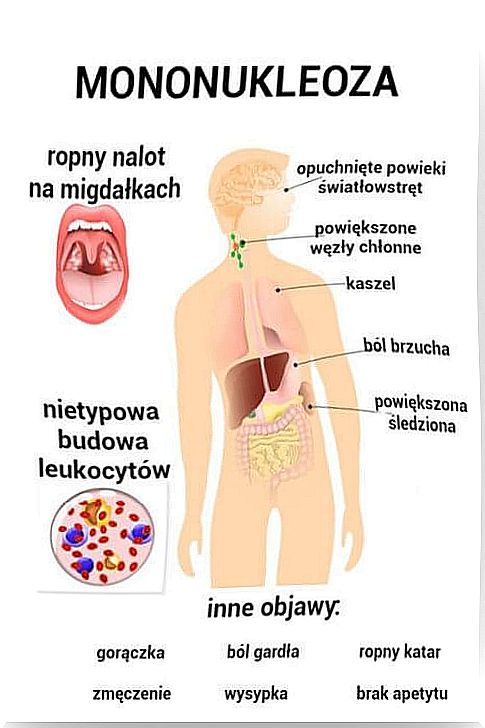Infectious Mononucleosis – What Have You Not Heard About It ?!

Infectious mononucleosis is a disease caused by the Epstein-Barr virus (EBV), also known as human herpesvirus 4 (HHV-4). This disease occurs exclusively in humans. Usually children, teenagers and young adults suffer from it.
The Epstein-Barr virus has two key properties: it primarily attacks B lymphocytes and the oropharynx. After suffering from the disease, it remains in the body in a latent (hidden) form for the rest of its life. In today’s article, we will take a closer look at the EBV virus. Find out what infectious m ononucleosis is.
Mononucleosis – How does it get infected?
Infection with EBV occurs through droplets, most often through direct contact with the saliva of an infected person. Most often, carriers do not show any symptoms of the disease.
Due to the route of infection, mononucleosis is called “kissing disease”.
In addition, mononucleosis can be contracted from contact with objects such as cups and toothbrushes that are infected by their owners. There is also a risk of infection through the blood (during transfusion) and as a result of haematopoietic cell transplantation.
The age at which we are most likely to contract mononucleosis generally depends on the socioeconomic level. In developing countries, mononucleosis is a childhood disease. On the other hand, in highly developed countries, it is most common among teenagers.
Epstein-Barr virus infection
In people with an efficient immune system – EBV infection is usually asymptomatic and therefore goes unnoticed.

The response caused by the virus in the body varies with age:
- In children, EBV infection is asymptomatic in most cases
- In adolescents and young adults, the virus may be asymptomatic or cause infectious mononucleosis
- In people over the age of 40, primary EBV infection often contributes to viral hepatitis
It should be noted that the situation is different in people with weakened immunity (eg in the course of AIDS). In such people, infection with the Epstein-Barr virus can cause diseases of the lymphatic system.
Mononucleosis – symptoms
Infectious mononucleosis has an incubation period of 4 to 6 weeks.
During this period, the patient usually shows flu-like symptoms: fatigue, general weakness, low-grade fever or a fever below 38 ° C.

Then the characteristic symptoms of mononucleosis appear:
- very painful pharyngitis and tonsillitis
- high fever (over 38 ° C)
- cervical lymphadenopathy – the lymph nodes in the neck are clearly enlarged; this is one of the most characteristic symptoms of mononucleosis p
- splenomegaly – enlargement of the spleen, occurs in half of the cases
- sometimes a complication of the disease may be asthenia (an exceptional body weakness)
Diagnosis
The diagnosis is lymphocytosis, with the number of lymphocytes over 4.5 thousand. / mm³. However, this is not a sufficient premise for a definitive diagnosis of infectious mononucleosis.
A distinction is made between benign lymphocytoses – those occurring in the course of inflammatory diseases and processes – and malignant ones in leukemias.
The basis of lymphocytosis can be determined by visual microscopic analysis of peripheral blood smears. The presence of atypical lymphocytes indicates a mild lymphocytosis.
Atypical lymphocytes are larger than normal and have a more disorganized nucleus. The reason for these changes is the stimulation of cells by antigens.

The test for the fastest confirmation of mononucleosis is the test for heterophile antibodies. The test is positive in 85% of patients with mononucleosis. In people with other diseases, the test is negative.
Heterophilic antibodies
The presence of heterophile IgM antibodies is a pathognomonic symptom of infection with Epstein-Barr virus. In other words, these types of antibodies are exclusively produced by the EBV virus.
The ability of heterophile antibodies to clump horse, bovine and sheep blood cells is of important diagnostic importance. This makes it possible to detect their presence using the Paul-Bunnell-Davidsohn reaction.
The relationship between the different types of antibodies allows doctors to distinguish an acute infection from an infection in the past
- in case of acute infection, most of the antibodies will be anti VCA-IgM Ac ; they can be detected in the blood up to 5 months after infection
- 4 weeks after the onset of the disease, anti-VCA-IgG Ac antibodies develop in the plasma ; while the anti EBNA-IgG Ac will be absent
- in the case of a history of infection, both anti VCA Ac and anti EBNA-IgG antibodies will be present in the plasma .
Differential diagnosis
In the event of symptoms suggesting mononucleosis, it is imperative to undergo a differential diagnosis. It should also be used in cases of suspected other causes of lymphocytosis, such as leukemia or lymphoma.
Treatment
Treatment of mononucleosis is symptomatic. It is worth adding that patients who have been given amoxicillin develop a rash all over the body, starting on the third day after taking the first dose of the antibiotic.
Infectious mononucleosis – complications
During mononucleosis, the spleen can rupture due to its particularly severe swelling, but this happens only in 1% of cases.
Mononucleosis can also lead to haemolytic anemia due to the possibility of destroying red blood cells by heterophile antibodies.
This results in the release of bilirubin, so patients with mononucleosis may develop jaundice (yellow discoloration of the skin and mucous membranes).

Additionally, mononucleosis can also be associated with:
- chronic fatigue syndrome
- Guillain-Barré syndrome
- patients with X-linked lymphoproliferative disease are unable to develop an immune response to EBV infection, it can even be fatal for them
Other EBV Related Diseases
Diseases associated with the Epstein-Barr virus, in addition to mononucleosis, also include:
- lymphoproliferative diseases
- nasopharyngeal cancer
- systemic lupus erythematosus and other autoimmune diseases









